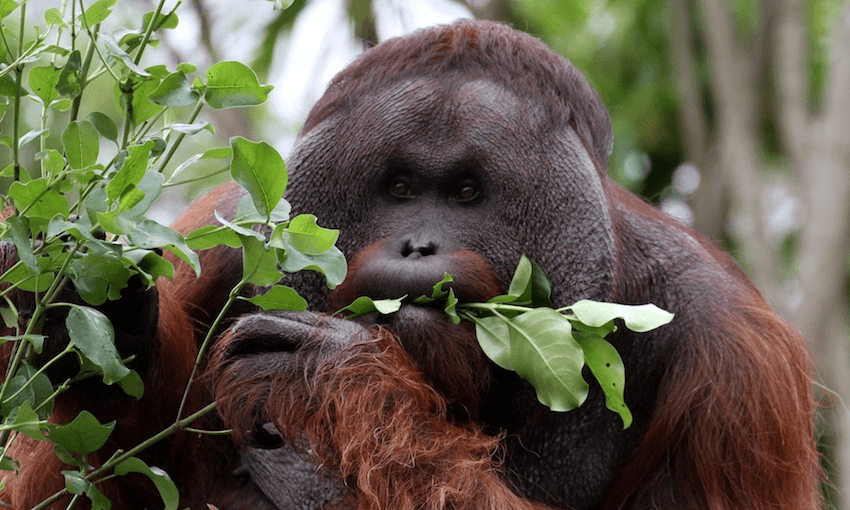Auckland Zoo is no longer about humans on the outside looking in at the animals. Now, it’s all about being part of the landscape together.
Monica Lake has handed me a high vis vest and a hard hat (my preferred outfit any given day) and is showing me around a large construction site: mounds of dirt, a drained, mossy lake and in the distance, what looks like a large concrete bunker. We’re looking out at what will become Auckland Zoo’s South East Asia track, home to orangutans, Siamang gibbons, Sumatran tigers, otters, crocodiles and other reptiles and fish.
To my right the zoo’s popular tiger exhibit lies empty, soon to be replaced by an open-air, multi-zoned habitat that will climb down the ridge, across where a large concrete causeway now stands. While we navigate the bulldozers and earthworks, Lake points out where every column, creature, tree and footpath will eventually be placed.
Listen to episode three of Good Ancestors, a four-part podcast that examines the role of children in our planet’s future on the player below, subscribe on iTunes, or download this episode (right click and save).
While her title, head of facility services, may sound a bit like she cleans the loos, in reality, Lake’s long career in architecture and environmental design has been a driving force behind the $150 million 10-year plan that will transform Auckland Zoo into a series of “landscape immersive experiences” rather than traditional enclosures.
“We talk about the importance of living landscapes where visitors and animals are all part of the same landscape and you’re not at a window looking into it. The work I do here is all about creating spaces where people can connect with wildlife, and each other. It’s not about a quick, catchy experience. It’s about that deep connection to the earth and caring for animals and each other.”
A fairly recent arrival from Washington state, Lake says the international zoo community is very small. During her 11 years at Seattle’s Woodland Park Zoo she worked with the same landscape architecture company that is now lead designer of the project laid out before us.
“Studio Hanson Roberts were part of the landscape architects, planners and scientists who developed the principles of an immersive landscape experience, and Auckland Zoo was actually one of the first zoos to become a part of that tradition. It’s one of the reasons Auckland Zoo looks the way it does today, because it has decades of projects that have been built on that concept. The alligators, South America, Africa [habitats], all of that is based on immersive landscape design.
“It’s not something you build in a day, the spaces and experiences must grow in. And that really creates that opportunity to take a journey with our visitors who are coming when they’re children and when they’re older and seeing themselves, their families and the zoo grow.”
She says the new landscapes they’re creating for both the tigers and the orangutans will allow for more functional use of the space, giving the animals a chance to observe the visitors without feeling seen, otherwise known as the theory of prospect and refuge – an innate instinct shared by humans.
“There’s nothing quite as wonderful as sitting with your back against a wall looking out. You know, you’re sitting at a café watching people drift by. For animals it’s about creating those spaces where they can be up on a knoll or looking out from a bush, but always feeling like their back is protected. That they’re controlling their space and they’re the masters of their own experience.”
Like the zoo’s African Savannah, where rhinos and nyala can be found cohabiting peacefully, or the Rainforest where squirrel monkeys occupy the treetops and vines while the capybara inhabit the forest floor and adjacent pools, South East Asia will continue to combine species in ways that mimic their natural habitats.
“It’s another one of the really basic components of landscape immersion, this layering of animals and habitats,” says Lake. “It’s not one animal, it’s showing the whole web of life that makes up an eco-system.”
We approach a large hole that is destined to become a tropical dome (an Indonesian swamp forest habitat), where Sunda gharial (a large Asian crocodile species) and many other fish and reptile species will live in a scientifically engineered environment that mimics the hot and humid tropics.
Lake reveals the concrete bunker in the distance is, in fact, the orangutans and siamangs’ new care quarters and assures me that once landscaped, visitors will hardly notice it’s there. Orangutan male Charlie and females Melur and Wanita are currently on holiday at Orana Wildlife Park in Christchurch, and will be returning to move into their new digs soon.
“One of the reasons we’ve built such a robust building is so we are able to control the temperature and humidity perfectly to mirror the jungle environment. After all, we’re mimicking a tropical climate. With orangutans and other primates, we need to able to keep the building warm and also moist. So we’re using bio-floors, where we have a really thick, deep mulch layer on the floor that holds a lot of moisture that humidifies the air. And secondly, we have shared shelters, you’re now looking into one of them here.
“As the visitor boardwalk goes across the care quarters, the orangutan and siamang area comes up to meet at what’s called a shared shelter. People are here looking across the landscape in front of them and the orangutans are able to come up under the same shelter. There’s heat and cover there, they’re still in the landscape, people are in the landscape and they’re sharing that shelter together.”
Lake explains what has gone into designing a space for the complex needs of these great apes.
“Many of our animal care (Life Sciences) staff have spent most of their lives understanding what are the needs of these animals, both from a physical perspective and also in terms of what they need for their psychological well-being, their family units and their individual preferences, their nutrition and their locomotion.”
The new exhibit will recognise that orangutans are entirely arboreal, meaning they live their whole lives off the ground, or at least that’s the ecological niche they occupy in the forest. Orangutans in zoos that spend time on the ground, or even on flat wooden platforms suspended up high, can display a behavior that involves voluntarily regurgitating food.
“Most orangutan exhibits have spaces on the ground, but this exhibit is built entirely in the trees and that’s why we’ve spent this last year bringing all these mature trees into this renewed habitat. We’re pairing them with these canopy climbers,” she says gesturing to what look like towering Len Lye sculptures.
“That promotes their good health. All the ways in which the evolution of their bodies has happened over the millennia is now enabled because they’re not walking on the ground. Maintaining their physical fitness as well as using their joints in ways that they’ve evolved to support.”
A network of ropes that connect the trees and canopy climbers will also connect to 20 metre high lines that go out over the central lake, over the heads of visitors below, bringing them almost face to face with diners at a brand new café built high up off the ground.
Lake reflects that it’s interactions like this that reinforce a sentiment she and her colleagues feel deeply: “Zoos are our best future hope for connecting people to nature.”
“There’s a lot of research that’s been done about how going to the zoo actually engages people in a way where they care about each other. A spider monkey has a baby monkey and you see people reach out to the hand of their child and pull them close. It’s at the heart of who we are.”
This content was created in paid partnership with Auckland Zoo. Learn more about our partnerships here.

